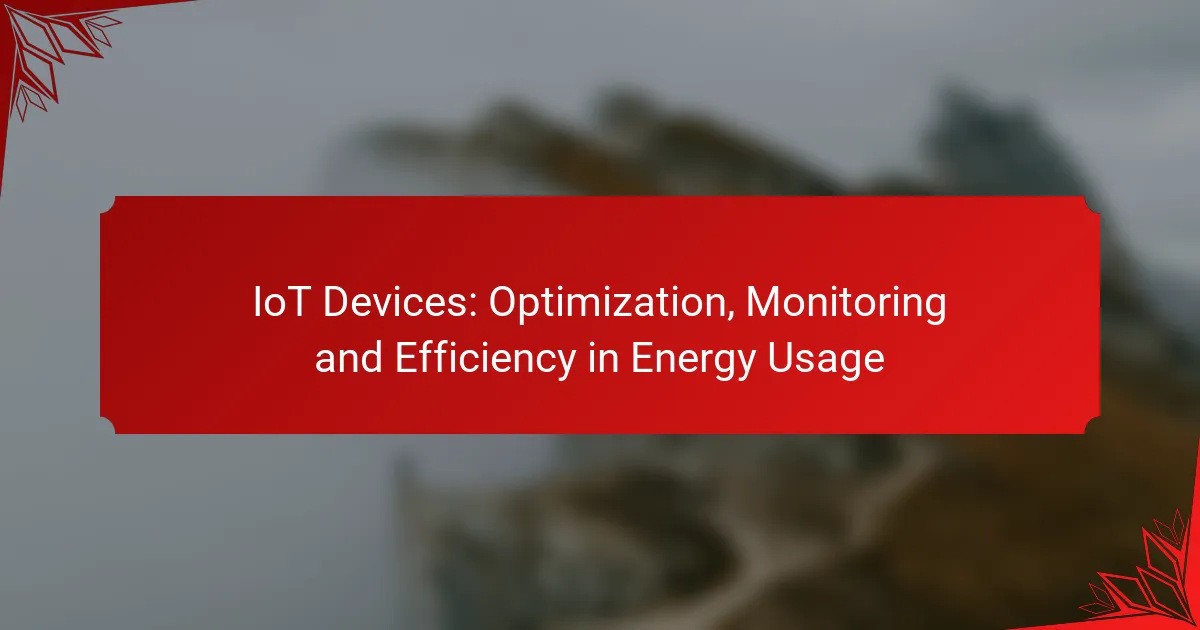The landscape of renewable energy is rapidly evolving, driven by emerging technologies that enhance efficiency and reduce costs. Innovations such as perovskite solar cells, floating wind farms, and advanced battery systems are at the forefront of this transformation, paving the way for a more sustainable energy future. As these technologies integrate with smart systems, they promise to make renewable energy more accessible and scalable than ever before.

What are the latest trends in renewable energy technologies?
The latest trends in renewable energy technologies focus on enhancing efficiency, reducing costs, and integrating smart systems. Innovations in solar, wind, energy storage, hydrogen fuel, and smart grid technologies are driving the transition to a more sustainable energy future.
Solar energy advancements
Recent advancements in solar energy include the development of more efficient photovoltaic cells and solar panels that can convert a higher percentage of sunlight into electricity. Technologies such as bifacial solar panels, which capture sunlight from both sides, are gaining popularity and can increase energy output by 10-20%.
Additionally, solar tracking systems that adjust the angle of panels throughout the day can further enhance energy capture. These innovations are making solar energy more viable for residential and commercial applications, often resulting in lower electricity bills and a quicker return on investment.
Wind energy innovations
Wind energy is seeing innovations in turbine design and technology, leading to larger and more efficient turbines. Modern turbines can now generate power at lower wind speeds, expanding the potential for wind farms in various locations, including those previously deemed unsuitable.
Floating wind farms are another emerging trend, allowing for installation in deeper waters where winds are stronger and more consistent. This technology can significantly increase energy production while minimizing land use and environmental impact.
Energy storage solutions
Energy storage solutions are crucial for balancing supply and demand in renewable energy systems. Lithium-ion batteries remain the dominant technology, but alternatives like solid-state batteries and flow batteries are being developed to improve safety and longevity.
Investments in energy storage are essential for integrating intermittent sources like solar and wind into the grid. Systems that can store energy for hours or even days help ensure a reliable power supply, especially during peak demand times or adverse weather conditions.
Hydrogen fuel developments
Hydrogen fuel is gaining traction as a clean energy carrier, particularly for sectors difficult to electrify, such as heavy industry and transportation. Green hydrogen, produced through electrolysis using renewable energy, is becoming increasingly cost-competitive.
Countries are investing in hydrogen infrastructure, including production, storage, and distribution networks. This trend is supported by government policies aimed at reducing carbon emissions and promoting sustainable energy solutions.
Smart grid technology
Smart grid technology is revolutionizing how energy is distributed and consumed. By using digital communication tools, smart grids enhance the efficiency and reliability of electricity delivery, allowing for real-time monitoring and management of energy resources.
These systems enable better integration of renewable energy sources, demand response strategies, and electric vehicle charging. Consumers can benefit from lower energy costs and increased control over their energy usage, while utilities can optimize grid performance and reduce outages.
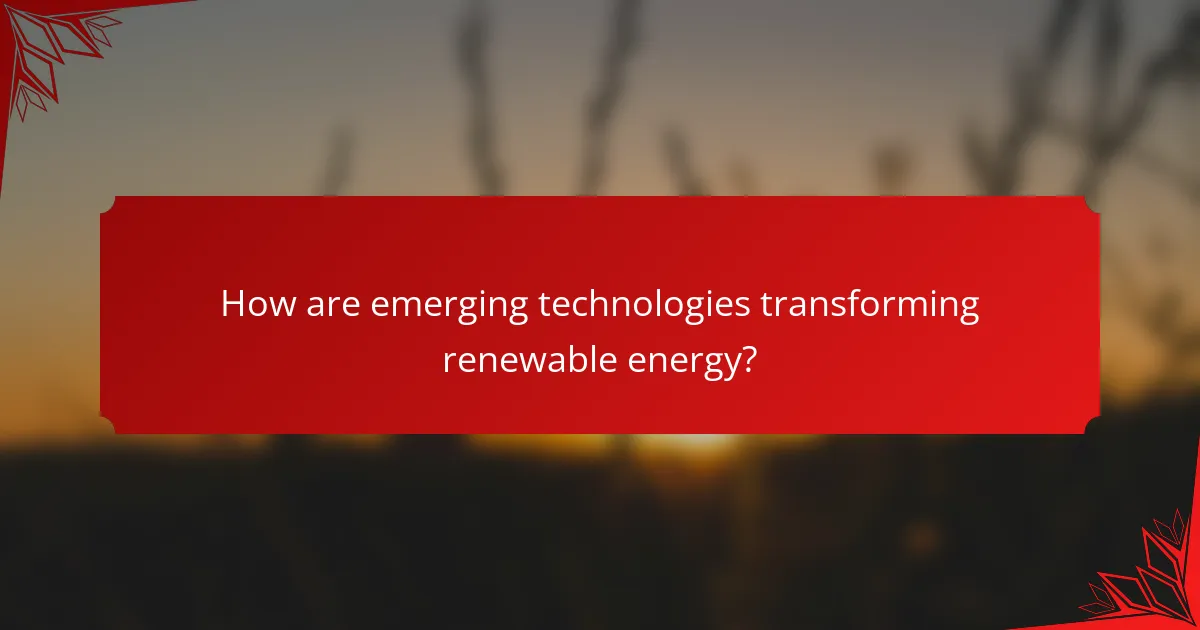
How are emerging technologies transforming renewable energy?
Emerging technologies are significantly enhancing the efficiency, accessibility, and sustainability of renewable energy sources. Innovations in solar, wind, and energy management systems are paving the way for a cleaner energy future.
Increased efficiency in solar panels
Recent advancements in solar panel technology have led to higher energy conversion rates, allowing panels to generate more electricity from the same amount of sunlight. Innovations such as bifacial solar panels and perovskite materials are pushing efficiency levels beyond 20%, making solar energy more competitive with traditional energy sources.
Additionally, integrating smart technology into solar systems enables real-time monitoring and optimization of energy production. Homeowners can now utilize apps to track performance and adjust settings, maximizing their solar investment.
Offshore wind energy expansion
The expansion of offshore wind energy is transforming the renewable landscape, particularly in regions with strong coastal winds. New turbine designs, including larger and more efficient models, are being deployed to harness wind energy more effectively, with capacities reaching up to 12 MW per turbine.
Countries like the UK and Germany are leading the way in offshore wind farms, which can generate significant amounts of electricity for millions of homes. The development of floating wind turbines is also opening up new areas for energy generation, allowing for installations in deeper waters where traditional fixed turbines are not feasible.
AI in energy management
Artificial intelligence (AI) is revolutionizing energy management by optimizing the distribution and consumption of renewable energy. AI algorithms analyze vast amounts of data to predict energy demand and supply, enabling utilities to balance loads more effectively and reduce waste.
Smart grids equipped with AI can autonomously adjust to fluctuations in energy production and consumption, enhancing reliability and efficiency. For businesses and homeowners, AI-driven energy management systems can lead to significant cost savings by optimizing energy use during peak and off-peak hours.

What are the key innovations in renewable energy for 2024?
Key innovations in renewable energy for 2024 include advancements in perovskite solar cells, the development of floating wind farms, and improvements in advanced battery technologies. These innovations aim to enhance efficiency, reduce costs, and increase the scalability of renewable energy systems.
Perovskite solar cells
Perovskite solar cells are a promising innovation due to their high efficiency and low production costs. They utilize a unique crystal structure that allows for better light absorption compared to traditional silicon cells. As of 2024, ongoing research aims to improve their stability and longevity, making them a viable option for widespread use.
These cells can be manufactured using simpler processes, potentially reducing costs to below $0.50 per watt. However, challenges remain regarding their durability and environmental impact, which researchers are actively addressing.
Floating wind farms
Floating wind farms represent a significant advancement in harnessing wind energy, especially in deep-water locations where traditional turbines are not feasible. These farms can be placed further offshore, capturing stronger and more consistent winds, which can lead to higher energy outputs.
By 2024, floating wind technology is expected to lower the cost of offshore wind energy to competitive levels, with projects in regions like Europe and the U.S. demonstrating successful implementations. Key considerations include site selection, anchoring systems, and the integration of energy storage solutions.
Advanced battery technologies
Advanced battery technologies are crucial for improving energy storage capabilities, which is essential for balancing supply and demand in renewable energy systems. Innovations such as solid-state batteries and lithium-sulfur batteries promise higher energy densities and faster charging times compared to conventional lithium-ion batteries.
As these technologies mature in 2024, they are projected to enhance the performance of electric vehicles and grid storage systems, making renewable energy more reliable. Users should consider the trade-offs between cost, lifecycle, and environmental impact when selecting battery solutions for their needs.
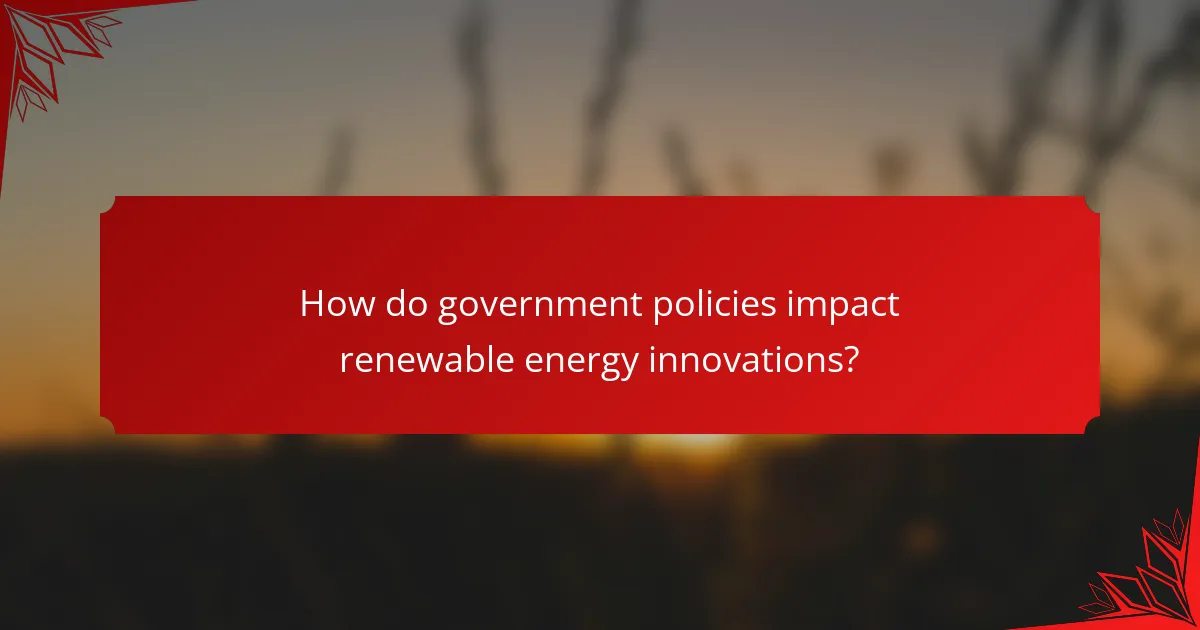
How do government policies impact renewable energy innovations?
Government policies play a crucial role in shaping renewable energy innovations by providing the necessary framework and support for development. These policies can include financial incentives, regulatory measures, and long-term commitments that encourage investment and research in renewable technologies.
Incentives for solar adoption
Financial incentives for solar adoption often include tax credits, rebates, and grants that lower the initial investment costs for homeowners and businesses. For example, in the United States, the federal solar tax credit allows individuals to deduct a significant percentage of the cost of installing solar panels from their federal taxes, making solar energy more accessible.
Additionally, many states offer their own incentives, which can vary widely. Some states provide performance-based incentives that pay solar system owners based on the energy their systems produce, while others may have net metering policies that allow users to sell excess energy back to the grid.
Regulations on emissions
Regulations on emissions are designed to limit the amount of greenhouse gases released into the atmosphere, thereby promoting cleaner energy sources. Governments often implement standards that require a gradual reduction in emissions from fossil fuel power plants, pushing utilities to invest in renewable energy solutions.
For instance, the European Union has set ambitious targets for reducing carbon emissions, which has led to increased investment in wind and solar energy. Companies that fail to meet these regulations may face significant fines, creating a strong incentive to innovate and adopt cleaner technologies.
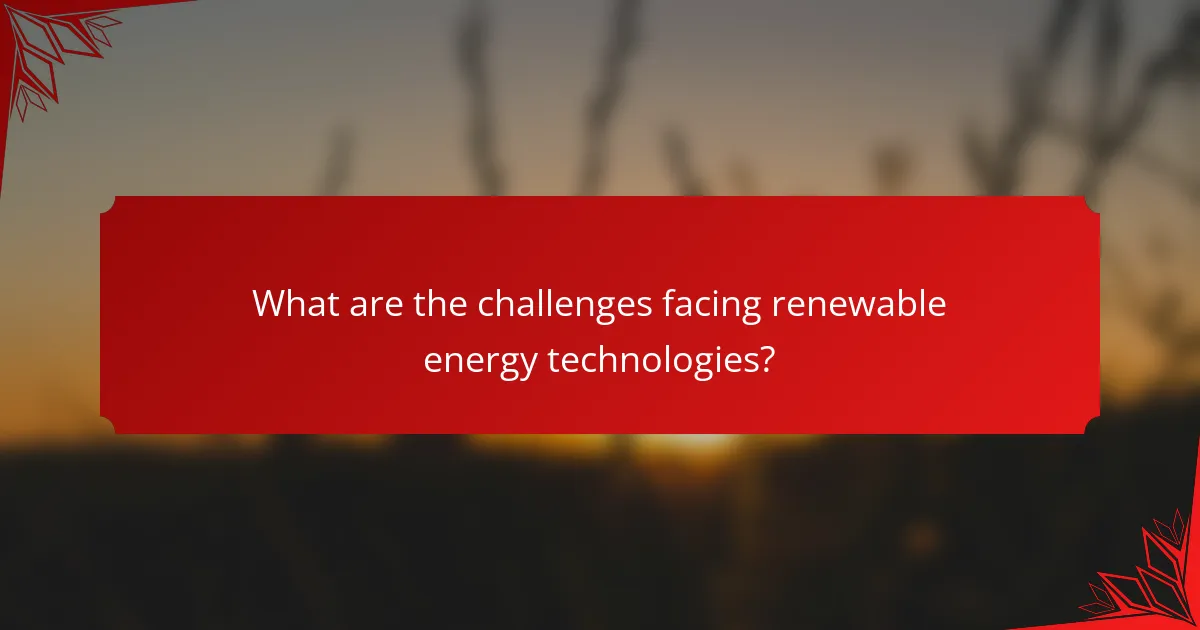
What are the challenges facing renewable energy technologies?
Renewable energy technologies face several significant challenges that can hinder their widespread adoption and effectiveness. Key issues include infrastructure limitations, market competition, and regulatory hurdles that can complicate implementation and growth.
Infrastructure limitations
Infrastructure limitations refer to the inadequacies in the existing energy grid and facilities that are necessary to support renewable energy sources. Many regions lack the necessary transmission lines and storage systems to efficiently distribute energy generated from renewable sources like wind and solar.
For instance, areas with high solar potential may not have the grid capacity to handle the influx of energy, leading to inefficiencies. Upgrading infrastructure can require substantial investment and time, often delaying the deployment of renewable technologies.
Market competition
Market competition poses a challenge as renewable energy technologies often compete with established fossil fuel industries that benefit from existing infrastructure and subsidies. This competition can create barriers for new entrants in the renewable sector, making it difficult for them to gain market share.
Additionally, fluctuating energy prices can impact the attractiveness of renewable investments. For example, when oil prices drop significantly, it can lead to reduced interest in renewable projects as traditional energy sources appear more economically viable in the short term.
Regulatory hurdles
Regulatory hurdles encompass the complex laws and policies that govern energy production and distribution. Different regions may have varying regulations that can either support or impede the growth of renewable energy technologies.
For instance, in some countries, lengthy permitting processes can delay project timelines, while in others, lack of clear incentives for renewable energy can stifle investment. Understanding local regulations and navigating them effectively is crucial for the successful implementation of renewable energy projects.
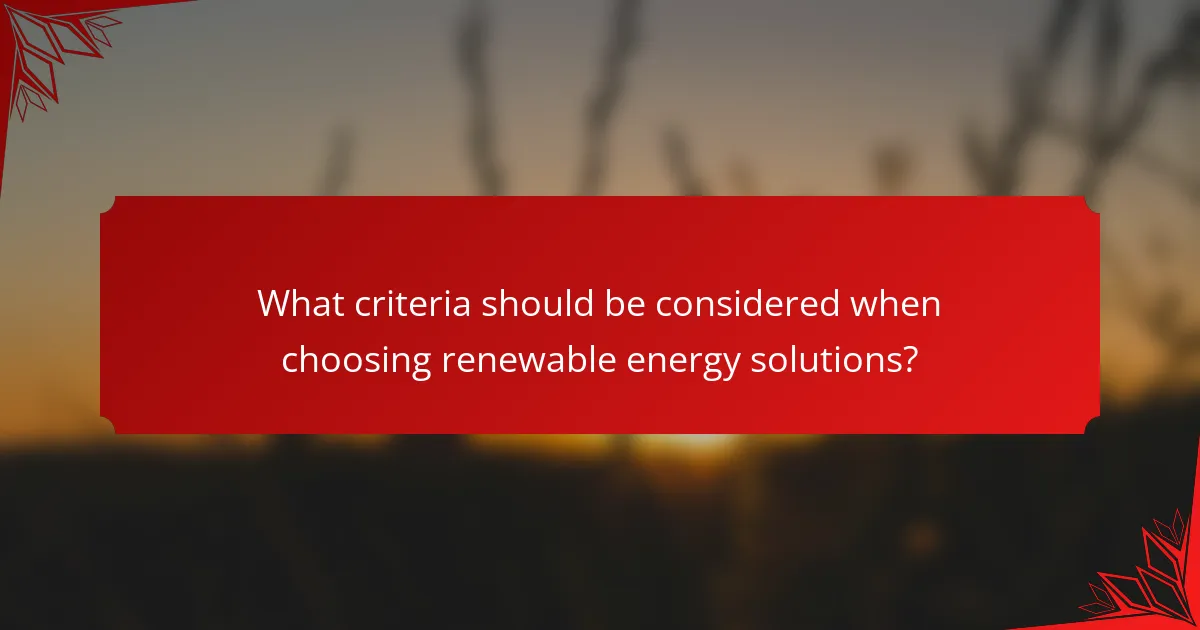
What criteria should be considered when choosing renewable energy solutions?
When selecting renewable energy solutions, key criteria include cost-effectiveness, environmental impact, scalability, and reliability. Evaluating these factors helps ensure that the chosen solution meets both financial and sustainability goals.
Cost-effectiveness
Cost-effectiveness is a critical criterion when choosing renewable energy solutions. It involves analyzing the initial investment, ongoing maintenance costs, and potential savings over time. Comparing the levelized cost of energy (LCOE) across different technologies can provide valuable insights.
For example, solar energy systems typically have low operating costs after installation, while wind energy can have higher upfront costs but may offer substantial long-term savings. It’s essential to consider local incentives, such as tax credits or grants, which can significantly reduce the overall expenditure.
Additionally, assessing the return on investment (ROI) is crucial. A solution with a longer payback period may still be viable if it offers higher efficiency or lower environmental impact. Always factor in potential fluctuations in energy prices and the longevity of the technology when making comparisons.

